A Life-Cycle Approach to Investigate the Potential of Novel Biobased Construction Materials toward a Circular Built Environment
Abstract
1. Introduction
2. Materials and Methods
2.1. Alternative Products under Study
- (a)
- Traditional wall assembly
- (b)
- CLT wall assembly
- (c)
- Bamboo wall assembly
- (d)
- Coconut wall assembly
2.2. Life-Cycle Assessment (LCA)
2.2.1. CLT Board Supply Chain
2.2.2. Bamboo Board Supply Chain
- (i)
- Trimming of the culm using an electric saw;
- (ii)
- Gluing with urea formaldehyde resin, and pressing;
- (iii)
- Trimming of the boards using an electrical table saw.
2.2.3. Coconut Board Supply Chain
- Husks of mature coconuts, which are grown for coconut oil. Burning these relatively dry husks as waste directly on the farms results in their complete combustion to CO2 and water vapor, with negligible local air pollution. While in Asia these mature husks are used as peat soil media, this practice is not widely established in Ghana.
- Husks of younger coconuts, which are grown for coconut water. These too are “burnt on the farms to facilitate the harvesting process” [64], but the burning of this higher-moisture-content waste results in “air pollution and blocked roadside drains that facilitate the breeding of mosquitoes” [70]. While this second type of waste may also be utilized for the production of biomaterials, there is not enough quantitative information to accurately estimate the environmental credits due to the avoided air pollution when the waste is collected for the production of biomaterials instead of burnt on site. As a result, the conservative assumption was made that the coconut coir boards under analysis here would be produced out of mature coconut husks only.
- (i)
- Manual crushing and decortication. Coconut pith, containing over 60% TDN (1,1,6,-trimethyl-1,2-dihydronapthalene), is also obtained as a byproduct, which can later be used as a binder [24];
- (ii)
- Shredding of the fiber in a hammer mill;
- (iii)
- Thermal pressing of the fiber, sprinkled with coconut pith or soy protein bio-binder in a hydraulic press;
- (iv)
- Trimming of the boards using an electric table saw.
3. Results
4. Discussion
Supplementary Materials
Author Contributions
Funding
Conflicts of Interest
References
- Hertwich, E.; Lifset, R.; Pauliuk, S.; Heeren, N. Resource Efficiency and Climate Change: Material Efficiency Strategies for a Low-Carbon Future-Summary for Policymakers; IRP Reports; United Nations Environment Programme: Nairobi, Kenya, 2020. [Google Scholar]
- Hertwich, E.G. Increased carbon footprint of materials production driven by rise in investments. Nat. Geosci. 2021, 14, 151–155. [Google Scholar] [CrossRef]
- Allwood, J.M.; Ashby, M.F.; Gutowski, T.G.; Worrell, E. Material efficiency: A white paper. Resour. Conserv. Recycl. 2011, 55, 362–381. [Google Scholar] [CrossRef]
- Gonzalez, M.J.; Navarro, J.G. Assessment of the decrease of CO2 emissions in the construction field through the selection of materials: Practical case study of three houses of low environmental impact. Build. Environ. 2006, 41, 902–909. [Google Scholar] [CrossRef]
- United States Geological Survey Mineral Commodity Summaries 2022. Reston, VA, USA. 2022. Available online: https://pubs.usgs.gov/periodicals/mcs2022/mcs2022.pdf (accessed on 3 August 2022).
- World Bank Housing for All by 2030. Available online: https://www.worldbank.org/en/news/infographic/2016/05/13/housing-for-all-by-2030 (accessed on 3 August 2022).
- Wiedenhofer, D.; Fishman, T.; Lauk, C.; Haas, W.; Krausmann, F. Integrating Material Stock Dynamics Into Economy-Wide Material Flow Accounting: Concepts, Modelling, and Global Application for 1900–2050. Ecol. Econ. 2019, 156, 121–133. [Google Scholar] [CrossRef]
- Horvath, A. Construction materials and the environment. Annu. Rev. Env. Resour. 2004, 29, 181–204. [Google Scholar] [CrossRef]
- Rock, M.; Saade, M.R.M.; Balouktsi, M.; Rasmussen, F.N.; Birgisdottir, H.; Frischknecht, R.; Habert, G.; Lutzkendorf, T.; Passer, A. Embodied GHG emissions of buildings—The hidden challenge for effective climate change mitigation. Appl. Energ. 2020, 258, 114107. [Google Scholar] [CrossRef]
- Churkina, G.; Organschi, A.; Reyer, C.P.O.; Ruff, A.; Vinke, K.; Liu, Z.; Reck, B.K.; Graedel, T.E.; Schellnhuber, H.J. Buildings as a global carbon sink. Nat. Sustain. 2020, 3, 269–276. [Google Scholar] [CrossRef]
- Laguarda-Mallo, M.F.; Espinoza, O. Awareness, perceptions and willingness to adopt Cross-Laminated Timber by the architecture community in the United States. J. Clean. Prod. 2015, 94, 198–210. [Google Scholar] [CrossRef]
- Robertson, A.B.; Lam, F.C.F.; Cole, R.J. A Comparative Cradle-to-Gate Life Cycle Assessment of Mid-Rise Office Building Construction Alternatives: Laminated Timber or Reinforced Concrete. Buildings 2012, 2, 245–270. [Google Scholar] [CrossRef]
- John, S.; Nebel, B.; Perez, N.; Buchanan, A.H. Environmental Impacts of Multistory Buildings Using Different Construction Materials; Christchurch: South Island, New Zealand, 2009. [Google Scholar]
- Chen, Y. Comparison of Environmental Performance of a Five-Storey Building Built with Cross-Laminated Timber and Concrete; Sustainable Building Science Program; University of British Columbia-Department of Wood Science: Vancouver, BC, Canada, 2012. [Google Scholar]
- Göswein, V.; Reichmann, J.; Habert, G.; Pittau, F. Land availability in Europe for a radical shift toward bio-based construction. Sustain. Cities Soc. 2021, 70, 102929. [Google Scholar] [CrossRef]
- Canavan, S.; Richardson, D.M.; Visser, V.; Le Roux, J.J.; Vorontsova, M.S.; Wilson, J.R.U. The global distribution of bamboos: Assessing correlates of introduction and invasion. Aob Plants 2016, 9, plw078. [Google Scholar] [CrossRef] [PubMed]
- Cruz-Rios, F.; Grau, D. Design for Disassembly: An Analysis of the Practice (or Lack Thereof) in the United States. In Construction Research Congress 2020: Project Management and Controls, Materials, and Contracts; American Society of Civil Engineers: Reston, VA, USA, 2020; pp. 992–1000. [Google Scholar]
- Woolf, D.; Amonette, J.E.; Street-Perrott, F.A.; Lehmann, J.; Joseph, S. Sustainable biochar to mitigate global climate change. Nat. Commun. 2010, 1, 56. [Google Scholar] [CrossRef] [PubMed]
- Woolf, D.; Lehmann, J.; Ogle, S.; Kishimoto-Mo, A.W.; McConkey, B.; Baldock, J. Greenhouse Gas Inventory Model for Biochar Additions to Soil. Environ. Sci. Technol. 2021, 55, 14795–14805. [Google Scholar] [CrossRef] [PubMed]
- Fearnside, P.M.; Lashof, D.A.; Moura-Costa, P. Accounting for time in mitigating global warming through land-use change and forestry. Mitig. Adapt. Strateg. Glob. Change 2000, 5, 239–270. [Google Scholar] [CrossRef]
- Ross, E. William McDonough + Partners, Benefits of Mass Timber and Cross-Laminated Timber. Available online: https://mcdonoughpartners.com/benefits-of-mass-timber-and-cross-laminated-timber/ (accessed on 27 July 2022).
- Hough, R. Rethinking Timber Buildings Seven Perspectives on the Use of Timber in Building Design and Construction; ARUP: London, UK, 2019; Available online: https://www.arup.com/-/media/arup/files/publications/r/rethinkingtimberbuildings.pdf (accessed on 3 August 2022).
- Schmidt, J.; Griffin, C.T. Barriers to the design and use of cross-laminated timber structures in high-rise multi-family housing in the United States. In Structures and Architecture; CRC Press: Boca Raton, FL, USA, 2013; pp. 2225–2231. [Google Scholar]
- van Dam, J.E.G.; van den Oever, M.J.A.; Teunissen, W.; Keijsers, E.R.P.; Peralta, A.G. Process for production of high density/high performance binderless boards from whole coconut husk—Part 1: Lignin as intrinsic thermosetting binder resin. Ind. Crop. Prod. 2004, 19, 207–216. [Google Scholar] [CrossRef]
- van Dam, J.E.G.; van den Oever, M.J.A.; Keijsers, E.R.P.; van der Putten, J.C.; Anayron, C.; Josol, F.; Peralta, A. Process for production of high density/high performance binderless boards from whole coconut husk—Part 2: Coconut husk morphology, composition and properties. Ind. Crop. Prod. 2006, 24, 96–104. [Google Scholar] [CrossRef]
- Lokko, M.-L.J. Invention, Design and Performance of Coconut Agrowaste Fiberboards for Ecologically Efficacious Buildings. Doctoral Dissertation, Rensselaer Polytechnic Institute, Troy, NY, USA, 2016. [Google Scholar]
- Lokko, M.; Rowell, M.; Dyson, A.; Rempel, A. Development of Affordable Building Materials Using Agricultural Waste By-Products and Emerging Pith, Soy and Mycelium Biobinders. In 32nd International Conference on Passive and Low Energy Architecture Proceedings; Pablo La Roche and Marc Schiler: Los Angeles, CA, USA, 2016; pp. 881–887. [Google Scholar]
- Lokko, M.-L.; Rempel, A. Intrinsic Evaporative Cooling with Natural Ventilation and Shading for Adaptive Thermal Comfort in Tropical Buildings. In Proceedings of the International Building Physics Conference, Syracuse, NY, USA, 25 September 2018; p. 22. [Google Scholar]
- Beck, H.E.; Zimmermann, N.E.; McVicar, T.R.; Vergopolan, N.; Berg, A.; Wood, E.F. Present and future Koppen-Geiger climate classification maps at 1-km resolution. Sci. Data 2018, 5, 180214. [Google Scholar] [CrossRef]
- International Code Council Code Council Ad Hoc Committee on Tall Wood Buildings. Available online: https://www.iccsafe.org/products-and-services/i-codes/code-development/cs/icc-ad-hoc-committee-on-tall-wood-buildings/ (accessed on 27 July 2022).
- Beck Group Mass Timber Market Analysis. Completed for Council of Western State Foresters. Available online: https://www.oregon.gov/ODF/Documents/ForestBenefits/Beck-mass-timber-market-analysis-report.pdf (accessed on 27 July 2022).
- Espinoza, O.; Trujillo, V.R.; Mallo, M.F.L.; Buehlmann, U. Cross-Laminated Timber: Status and Research Needs in Europe. Bioresources 2016, 11, 281–295. [Google Scholar] [CrossRef]
- Andersen, J.H.; Rasmussen, N.L.; Ryberg, M.W. Comparative life cycle assessment of cross laminated timber building and concrete building with special focus on biogenic carbon. Energ. Build. 2022, 254, 111604. [Google Scholar] [CrossRef]
- Smith, R.E.; Griffin, G.; Rice, T. Solid Timber Construction: Process, Practice, Performance; Report sponsored by American Institute of Architects, USDA Forest Products Laboratory and FPI Innovations; University of Utah, Integrated Technology in Architecture Center: Salt Lake City, UT, USA, 2015. [Google Scholar]
- Yazdi, A.J.; Fini, A.A.F.; Forsythe, P. Mass-customisation of cross-laminated timber wall systems at early design stages. Automat. Constr. 2021, 132, 103938. [Google Scholar] [CrossRef]
- Cary Kopczynski & Company. Cross Laminated Timber Feasibility Study—A Comparison between Cross Laminated Timber and Cast-in-Place Concrete Framing for Mid-Rise Urban Buildings; Cary Kopczynski & Company: Seattle, WA, USA, 2018. [Google Scholar]
- Concrete Reinforcing Steel Institute (CRSI). Cost Comparison of Cross Laminated Timber (CLT) and Cast-in-Place Reinforced Concrete Structures; Concrete Reinforcing Steel Institute (CRSI): Schaumburg, IL, USA, 2018; p. 4. [Google Scholar]
- Brandao, F.; Paio, A.; Antunes, N. Towards a Digitally Fabricated Disassemble-able Building System A CNC fabricated T-Slot Joint. Comput. Better Tomorrow 2018, 2, 11–20. [Google Scholar]
- Ahmed, S.; Arocho, I. Mass timber building material in the US construction industry: Determining the existing awareness level, construction-related challenges, and recommendations to increase its current acceptance level. Clean. Eng. Technol. 2020, 1, 100007. [Google Scholar] [CrossRef]
- Goh, Y.; Yap, S.P.; Tong, T.Y. Bamboo: The Emerging Renewable Material for Sustainable Construction. In Encyclopedia of Renewable and Sustainable Materials; Hashmi, S., Choudhury, I.A., Eds.; Elsevier: Oxford, UK, 2020; Volume 2, pp. 365–376. [Google Scholar]
- Syeda, A.; Shrujal, B.; Kumar, J. A case study on bamboo as green building material. Int. J. Eng. Adv. Technol. 2014, 4, 78–82. [Google Scholar]
- Nurdiah, E.A. The Potential of Bamboo as Building Material in Organic Shaped Buildings. Procd. Soc. Behv. 2016, 216, 30–38. [Google Scholar] [CrossRef]
- Yu, D.W.; Tan, H.W.; Ruan, Y.J. A future bamboo-structure residential building prototype in China: Life cycle assessment of energy use and carbon emission. Energ. Build. 2011, 43, 2638–2646. [Google Scholar] [CrossRef]
- Liese, W. Research on Bamboo. Wood Sci. Technol. 1987, 21, 189–209. [Google Scholar] [CrossRef]
- Liese, W. The Anatomy of Bamboo Culms; Brill: Leiden, The Netherlands, 1998; Volume 18. [Google Scholar]
- Anagal, V.; Darvekar, G.; Gokhale, V. Bamboo construction: Learning through experience. Archit. Time Space People 2010, 36–43. [Google Scholar]
- Bhalla, S.; West, R.P.; Bhagat, D.; Gupta, M.; Nagpal, A. Pre-engineered bamboo structures: A step towards sustainable construction. In Sustainability Issues in Civil Engineering; Springer: Berlin/Heidelberg, Germany, 2017; pp. 339–344. [Google Scholar]
- Vengala, J.; Mohanthy, B.; Raghunath, S. Seismic performance of bamboo housing–An overview. Proc. World Bamboo Congr. 2015, 1, 389–407. [Google Scholar]
- Osorio, L.; Trujillo, E.; Lens, F.; Ivens, J.; Verpoest, I.; Van Vuure, A.W. In-depth study of the microstructure of bamboo fibres and their relation to the mechanical properties. J. Reinf. Plast. Comp. 2018, 37, 1099–1113. [Google Scholar] [CrossRef]
- Baksy, A. The bamboo industry in India: Supply chain structure, challenges and recommendations. Chall. Recomm. 2013. Available online: http://dx.doi.org/10.2139/ssrn.2442953 (accessed on 4 May 2014). [CrossRef]
- Richard, M.J. Assessing the Performance of Bamboo Structural Components. Doctoral Dissertation, University of Pittsburgh, Pittsburgh, Pennsylvania, 2013. [Google Scholar]
- Muchiri, M.; Muga, M. Country Profile of Climate Change Mitigation Potential of Implementing Sustainable Management for Bamboo Forests in Kenya; INBAR Working Paper; International Bamboo and Rattan Organisation: Beijing, China, 2021; Available online: https://www.inbar.int/wp-content/uploads/2021/08/INBAR_Climate-change-mitigation-poetntial-of-bamboo-forests-in-Kenya.pdf (accessed on 3 August 2022).
- van der Lugt, P.; Vogtländer, J.; Brezet, H. Bamboo, a Sustainable Solution for Western Europe: Design Cases LCAs and Land-Use; Centre for Indian Bamboo Resource and Technology: New Delhi, India, 2008. [Google Scholar]
- Yu, Y.; Tian, G.L.; Wang, H.K.; Fei, B.H.; Wang, G. Mechanical characterization of single bamboo fibers with nanoindentation and microtensile technique. Holzforschung 2011, 65, 113–119. [Google Scholar] [CrossRef]
- Maalouf, C.; Umurigirwa, B.S.; Viens, N.; Lachi, M.; Mai, T.H. Study of the Hygric Behaviour and Moisture Buffering Performance of a Hemp-Starch Composite Panel for Buildings. Bioresources 2015, 10, 336–347. [Google Scholar] [CrossRef]
- Ansell, M.P.; Lawrence, M.; Jiang, Y.H.; Shea, A.; Hussain, A.; Calabria-Holley, J.; Walker, P. Natural plant-based aggregates and bio-composite panels with low thermal conductivity and high hygrothermal efficiency for applications in construction. In Nonconventional and Vernacular Construction Materials: Characterisation, Properties and Applications; Woodhead Publishing: Cambridge, England, 2020; pp. 217–245. [Google Scholar]
- Lugt, P.; Vogtlander, J. The Environmental Impact of Industrial Bamboo Products—Life-Cycle Assessment and Carbon Sequestration; The International Network for Bamboo and Rattan: Beijing, China, 2015. [Google Scholar]
- International Energy Agency. IEA Africa Energy Outlook 2022; International Energy Agency: Paris, France, 2022. [Google Scholar]
- ISE. Photovoltaics Report; Fraunhofer Institute for Solar Energy Systems with assistance of PSE Projects GmbH: Munich, Germany, 2022. [Google Scholar]
- Frischknecht, R.; Itten, R.; Wyss, F.; Blanc, I.; Heath, G.A.; Raugei, M.; Sinha, P.; Wade, A. Life Cycle Assessment of Future Photovoltaic Electricity Production from Residential-Scale Systems Operated in Europe; National Renewable Energy Lab.(NREL): Golden, CO, USA, 2015.
- Ecoinvent, Ecoinvent Life Cycle Database. 2022. Available online: http://ecoinvent.org (accessed on 1 July 2022).
- Lehmann, S. Developing a Prefabricated Low-Carbon Construction System Using Cross-Laminated Timber (Clt) Panels for Multistorey Inner-City Infill Housing in Australia. J. Green Build. 2012, 7, 131–150. [Google Scholar] [CrossRef]
- Food and Agriculture Organization of the United Nations FAOSTAT Statistical Database. Crops and Livestock Products; FAO: Rome, Italy, 2022; Available online: https://www.fao.org/faostat/en/#data/QCL (accessed on 3 August 2022).
- Duku, M.H.; Gu, S.; Ben Hagan, E. A comprehensive review of biomass resources and biofuels potential in Ghana. Renew. Sustain. Energ Rev. 2011, 15, 404–415. [Google Scholar] [CrossRef]
- Salzer, C.; Wallbaum, H.; Ostermeyer, Y.; Kono, J. Environmental performance of social housing in emerging economies: Life cycle assessment of conventional and alternative construction methods in the Philippines. Int. J. Life Cycle Ass. 2017, 22, 1785–1801. [Google Scholar] [CrossRef]
- Nordic Structures Environmental Product Declaration: Nordic X-Lam TM. Available online: https://www.nordic.ca/data/files/datasheet/file/EPD_Nordic_X-Lam.pdf (accessed on 27 July 2022).
- Republic of Kenya. National Bamboo Policy; Republic of Kenya: Nairobi, Kenya, 2019. [Google Scholar]
- van der Lugt, P.; Vogtländer, J.; Van Der Vegte, J.; Brezet, J. Environmental assessment of industrial bamboo products—life cycle assessment and carbon sequestration. In 10th World Bamboo Congress, 2015; World Bamboo Organization: Antwerp, Belgium, 2015; pp. 1–16. [Google Scholar]
- Escamilla, E.Z.; Habert, G. Environmental impacts of bamboo-based construction materials representing global production diversity. J. Clean. Prod. 2014, 69, 117–127. [Google Scholar] [CrossRef]
- Obeng, G.Y.; Amoah, D.Y.; Opoku, R.; Sekyere, C.K.; Adjei, E.A.; Mensah, E. Coconut wastes as bioresource for sustainable energy: Quantifying wastes, calorific values and emissions in Ghana. Energies 2020, 13, 2178. [Google Scholar] [CrossRef]
- Quintana-Gallardo, A.; Alba, J.; del Rey, R.; Crespo-Amoros, J.E.; Guillen-Guillamon, I. Life-Cycle Assessment and Acoustic Simulation of Drywall Building Partitions with Bio-Based Materials. Polymers 2020, 12, 1965. [Google Scholar] [CrossRef]
- Barrio, A.; Francisco, F.B.; Leoncini, A.; Wietschel, L.; Thorenz, A. Life Cycle Sustainability Assessment of a Novel Bio-Based Multilayer Panel for Construction Applications. Resources 2021, 10, 98. [Google Scholar] [CrossRef]
- Mensah, T.N.O.; Oyewo, A.S.; Breyer, C. The role of biomass in sub-Saharan Africa’s fully renewable power sector—The case of Ghana. Renew. Energ. 2021, 173, 297–317. [Google Scholar] [CrossRef]

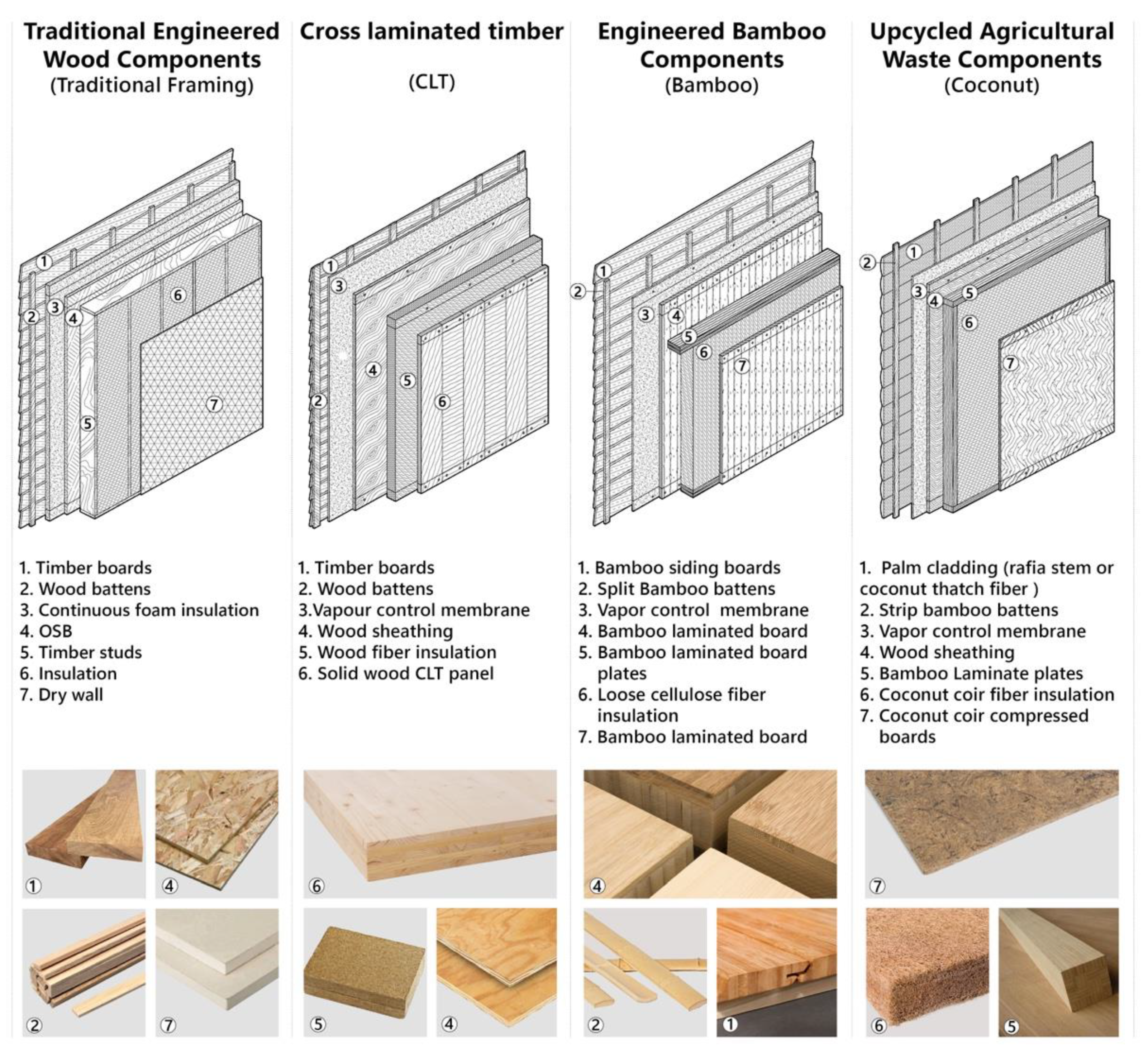


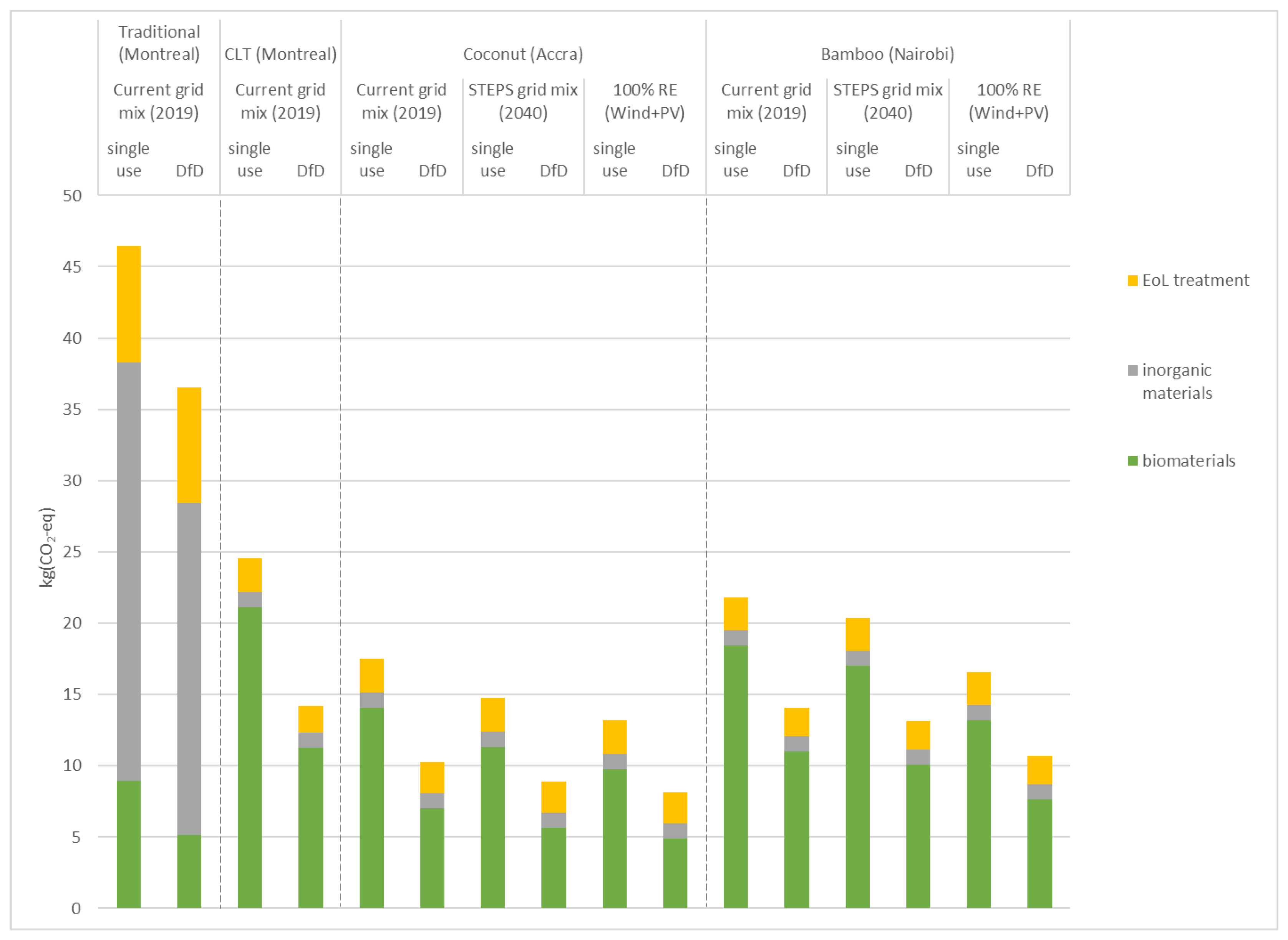
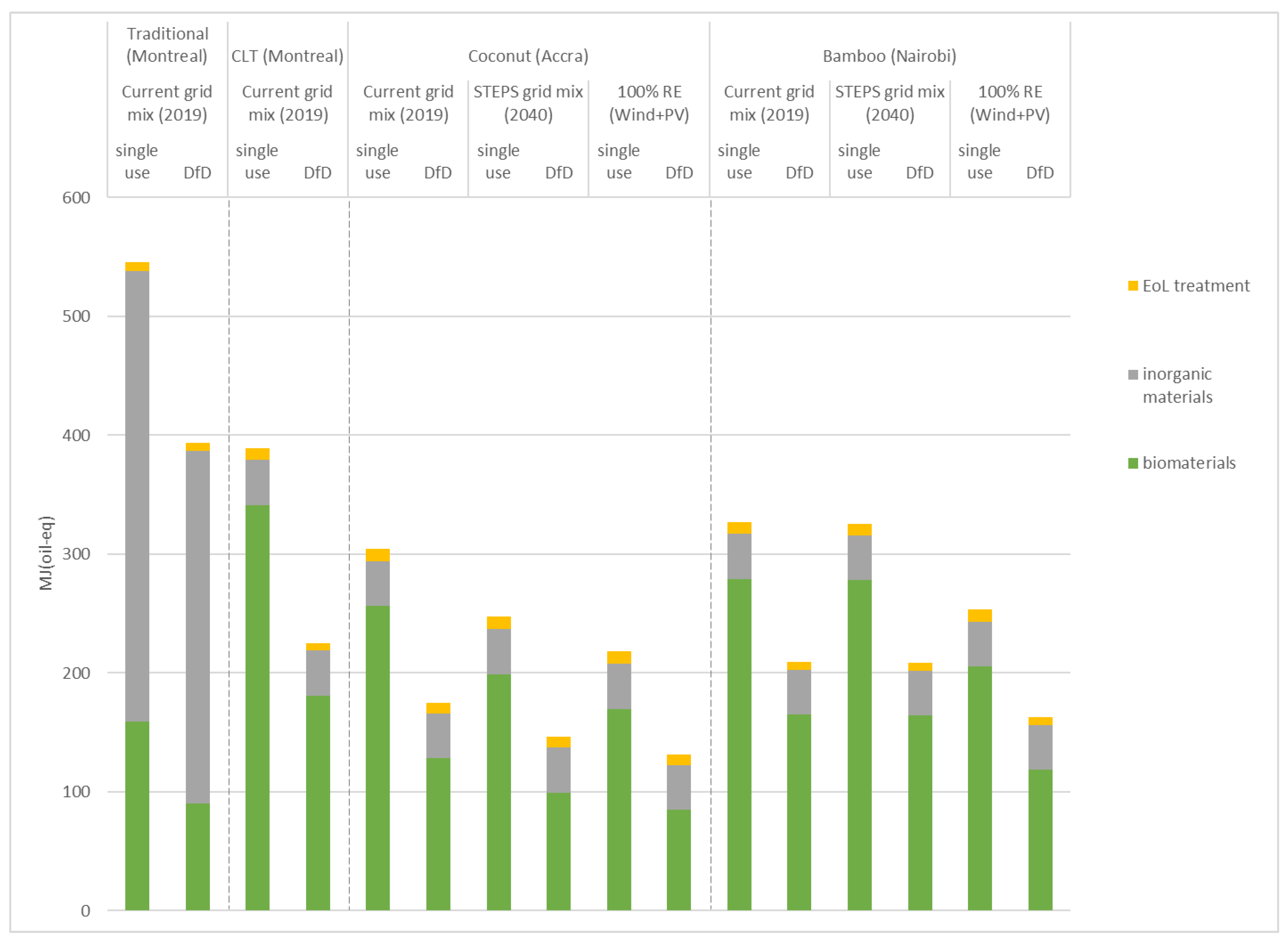

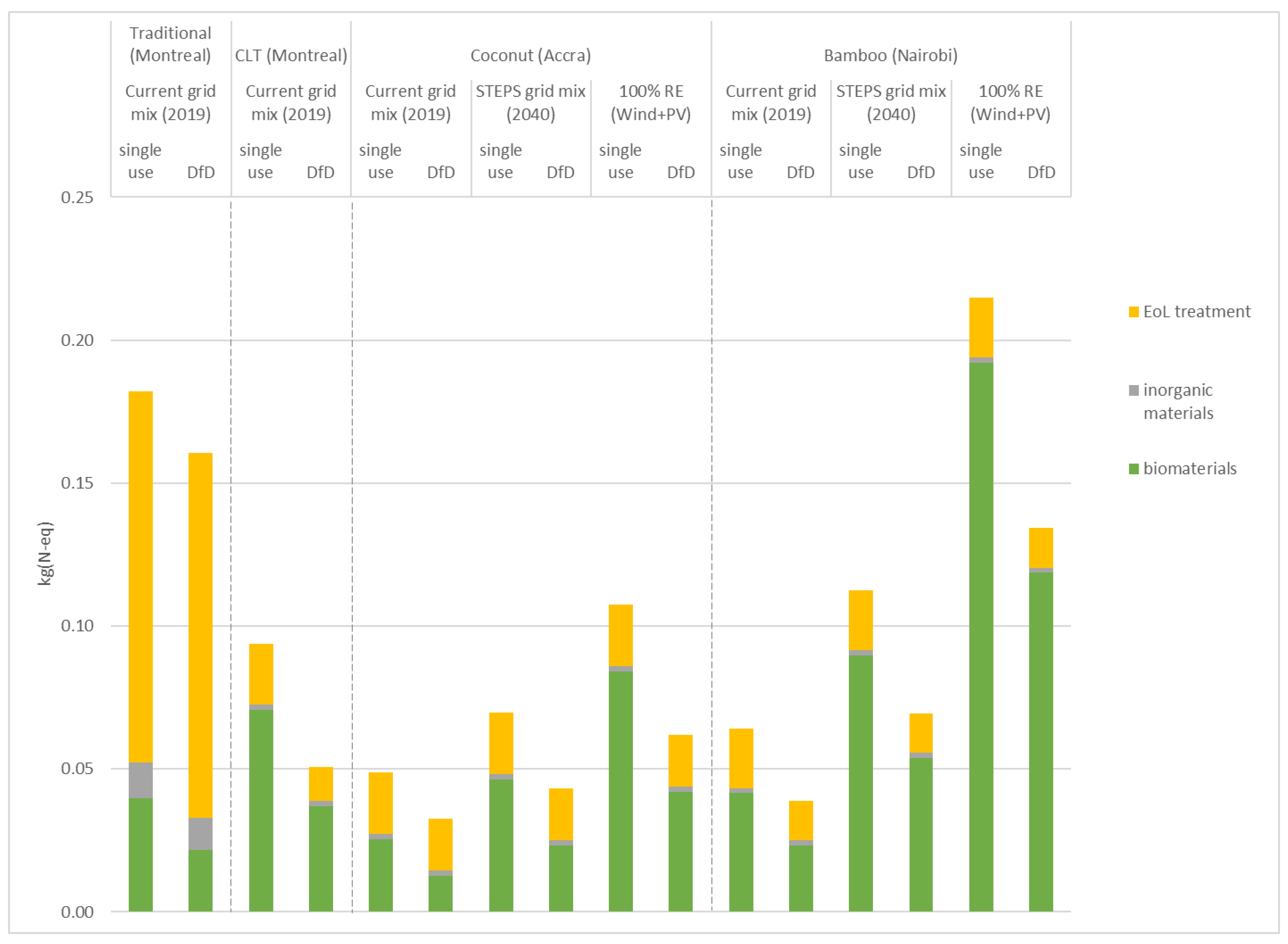
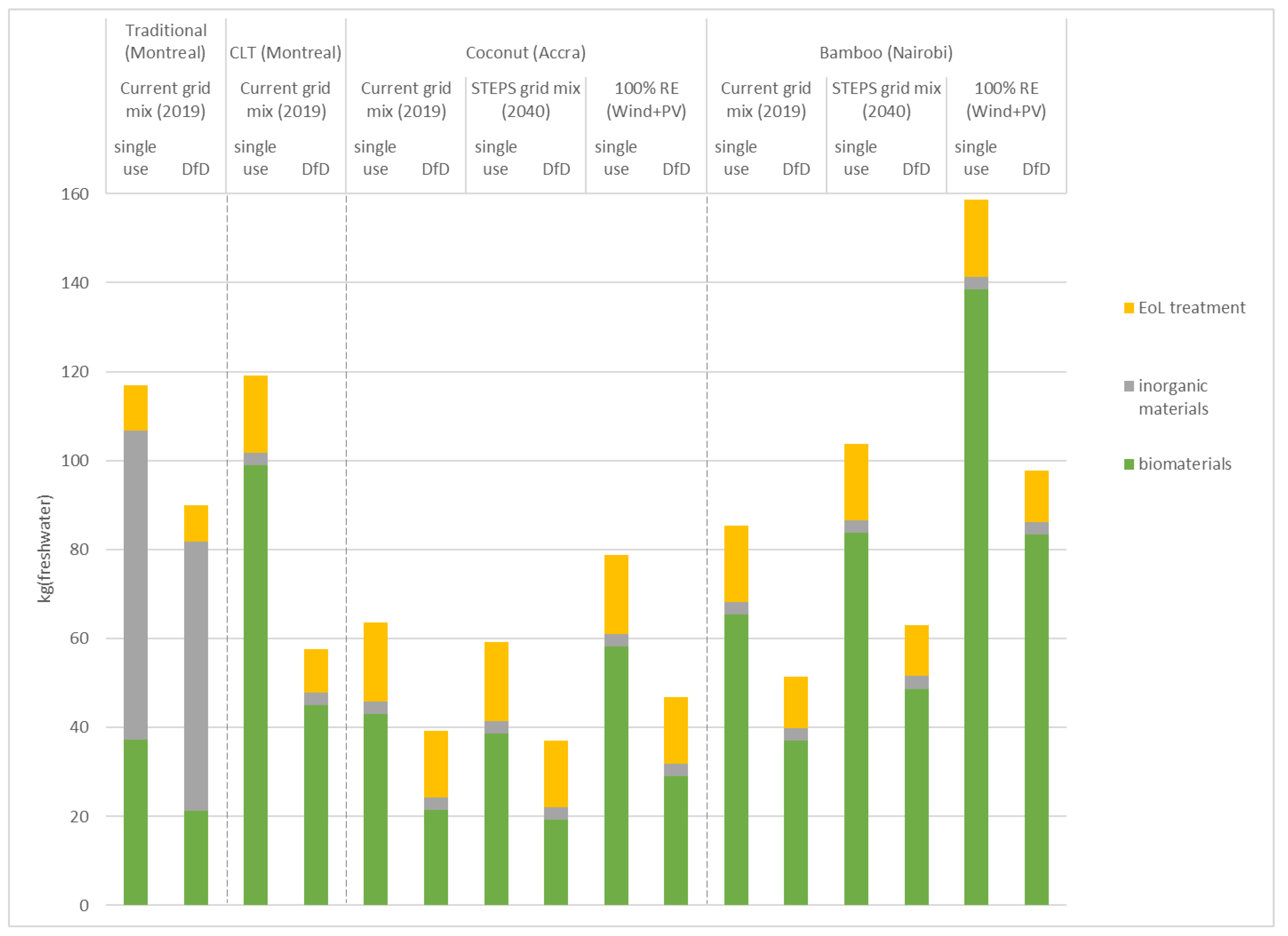
| Material | Reference Flow | Units | Potential for Reuse at EoL |
|---|---|---|---|
| Gypsum board | 7.8 | kg | No |
| Rockwool panels (HD) | 16 | kg | Yes |
| OSB engineered wood panel | 0.019 | m3 | Yes |
| Sawn softwood, dried (u = 20%) | 0.0020 | m3 | Yes |
| Red cedarwood | 0.020 | m3 | No |
| Material | Reference Flow | Units | Potential for Reuse at EoL |
|---|---|---|---|
| CLT board | 0.055 | m3 | Yes |
| Polyethylene, high-density | 0.46 | kg | No |
| Plywood, for outdoor use | 0.010 | m3 | Yes |
| Sawn softwood, dried | 0.021 | m3 | Yes |
| Red cedarwood | 0.020 | m3 | No |
| Wood fiber insulation | 16 | kg | Yes |
| Material | Reference Flow | Units | Potential for Reuse at EoL |
|---|---|---|---|
| Bamboo boards | 0.018 | m3 | No |
| Polyethylene, high-density | 0.50 | kg | No |
| Bamboo panel | 0.040 | m3 | Yes |
| Compressed bamboo beam and batten (HD) | 0.0080 | m3 | Yes |
| Cellulose fiber insulation | 8.0 | kg | Yes |
| Material | Reference Flow | Units | Potential for Reuse at EoL |
|---|---|---|---|
| Coconut coir boards, high-density | 0.0050 | m3 | Yes |
| Polyethylene, high-density | 0.50 | kg | No |
| Plywood, for outdoor use | 0.010 | m3 | Yes |
| Compressed bamboo beam and batten (HD) | 0.0080 | m3 | Yes |
| Coconut fiber insulation | 45 | kg | No |
| Location | Koppen–Geiger Climate Classification | Recommended R-Value for Wall | R-Value for Each Wall Type |
|---|---|---|---|
| Montreal | Dfb—warm summer, cold winter | 23 | 23 (traditional timber frame and CLT) |
| Nairobi | Cfb—warm and temperate | 13 | 14 (bamboo) |
| Accra | Aw—tropical savanna | 13 | 15 (coconut) |
Publisher’s Note: MDPI stays neutral with regard to jurisdictional claims in published maps and institutional affiliations. |
© 2022 by the authors. Licensee MDPI, Basel, Switzerland. This article is an open access article distributed under the terms and conditions of the Creative Commons Attribution (CC BY) license (https://creativecommons.org/licenses/by/4.0/).
Share and Cite
Keena, N.; Raugei, M.; Lokko, M.-l.; Aly Etman, M.; Achnani, V.; Reck, B.K.; Dyson, A. A Life-Cycle Approach to Investigate the Potential of Novel Biobased Construction Materials toward a Circular Built Environment. Energies 2022, 15, 7239. https://doi.org/10.3390/en15197239
Keena N, Raugei M, Lokko M-l, Aly Etman M, Achnani V, Reck BK, Dyson A. A Life-Cycle Approach to Investigate the Potential of Novel Biobased Construction Materials toward a Circular Built Environment. Energies. 2022; 15(19):7239. https://doi.org/10.3390/en15197239
Chicago/Turabian StyleKeena, Naomi, Marco Raugei, Mae-ling Lokko, Mohamed Aly Etman, Vicki Achnani, Barbara K. Reck, and Anna Dyson. 2022. "A Life-Cycle Approach to Investigate the Potential of Novel Biobased Construction Materials toward a Circular Built Environment" Energies 15, no. 19: 7239. https://doi.org/10.3390/en15197239
APA StyleKeena, N., Raugei, M., Lokko, M.-l., Aly Etman, M., Achnani, V., Reck, B. K., & Dyson, A. (2022). A Life-Cycle Approach to Investigate the Potential of Novel Biobased Construction Materials toward a Circular Built Environment. Energies, 15(19), 7239. https://doi.org/10.3390/en15197239









